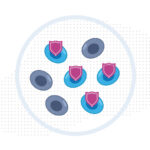Forecasting the future for childhood cancer survivors

Children are much more likely to survive cancer today than 50 years ago. Unfortunately, as adults, many of them develop cardiovascular disease, secondary cancers, or both, believed to result from the toxic effects of chemotherapy and radiation. But the full risk picture for survivors hasn’t been clear.
“Patients want to know how long they’ll live once they’ve been treated for cancer. They ask, ‘What’s going to happen to me?’” says pediatric oncologist Lisa Diller, MD, who founded the cancer survivorship program at Dana-Farber/Boston Children’s Cancer and Blood Disorders Center. “Our question was, can we look at more than one outcome at a time and have a comprehensive model of what life looks like for survivors as they age?”
Patients want to know how long they’ll live once they’ve been treated for cancer. They ask, ‘What’s going to happen to me?’
Diller is coauthor of a study in JAMA Oncology that used simulation modeling to answer this question. Led by Jennifer Yeh, PhD, a decision scientist in the Division of General Pediatrics at Boston Children’s Hospital, the study estimated the total lifetime risk for cardiovascular conditions and subsequent cancers, as well as their age of onset.
Based on their findings, the researchers are calling for clinicians to offer cancer survivors preventive health screenings and interventions decades before people without a childhood cancer history typically receive them.
Early onset of secondary health conditions
The investigators obtained data on children diagnosed with cancer between 1970 and 1999 who were alive at least five years after treatment, drawn from the Childhood Cancer Survivor Study (CCSS) and other national data sources.
From these data, they created a model called COMPASS (Cancer Outcomes Microsimulation: Pediatric and Adolescent SurvivorShip) to estimate the lifetime risks of eight subsequent health conditions among survivors. These included six aging-related conditions (breast cancer, colorectal cancer, heart failure, coronary artery disease or myocardial infarction, valvular disease, and stroke) and two common, life-threatening secondary cancers (glial tumors and sarcomas).
Their key findings:
- Five-year cancer survivors developed their first secondary health condition by an average age of 47 — nearly 18 years ahead of the general population. By age 65, 55 percent had at least one of the eight conditions, and 29 percent had two or more, versus 20 percent and 4 percent of the general population, respectively.
- Survivors who had received radiation therapy were at especially high risk, developing one of the eight conditions 22 years ahead of the general population. However, even survivors who did not receive radiation developed at least one condition 13.5 years ahead of the general population.
- Survivors who reached age 40 in good health were still 6.2 times more likely than the general population to develop one of the eight conditions within 10 years.
- Survivors had a reduced life expectancy: 46 percent passed away before age 65 versus 15 percent of the general population.
- Risk varied by the type of original cancer. Survivors of central nervous system tumors had the earliest onset of at least one health condition, an average of 24 years earlier than the general population. For leukemia survivors, this was just 11 years.
Can long-term health be improved in cancer survivors?
The analysis found that survivors of all diagnoses were at risk for accelerated onset of health conditions, regardless of prior radiation exposure.
Both Yeh and Diller note that many of the eight conditions they looked at have preventive measures that could make a difference in their outcome.
“Internal medicine has age-based care guidelines for breast and colon cancer screening, measuring blood lipid levels, treating mild hypertension, and other tests and interventions,” says Diller. “All of those guidelines should probably be applied at a much younger age in cancer survivors. Assessing the harms and benefits of some of these interventions is the focus of ongoing work.”
Diller hopes the model’s estimates will be incorporated into the Children’s Oncology Group’s survivorship guidelines and lead to risk assessment tools that adult internal medicine providers can readily use.
What about cancer patients treated today?
The study and an accompanying editorial in JAMA Oncology describe cancer survivors’ increased health risks as a form of accelerated aging, which can also include frailty, fatigue, reduced strength, and cognitive impairment. But cancer treatment has changed since 1999. Do people treated more recently have a better long-term outlook?
It’s hard to know, says Diller. Recent treatment trends have favored trying to reduce the use of toxic therapies and using genetic profiling to identify patients who truly need aggressive treatment. These may lead to better outcomes in the future.
“For newer treatments, like CAR-T-cell therapies and antibody-based immunotherapies, we just don’t have any information yet on long-term survivorship,” Diller notes.
The CCSS is now assembling a cohort of more recently treated children, so there may be more answers soon. Future analyses will also examine whether preventive care and environmental and lifestyle factors modify survivors’ risk.
“We plan to use the COMPASS model to look at outcomes for specific treatment protocols or new therapeutic approaches to get an initial peek at what we might expect,” says Yeh. “Our current findings can provide a benchmark for assessing improvements over time.”
Learn more about Dana-Farber/Boston Children’s and our approach to supporting childhood cancer, including our survivorship program.
Related Posts :
-

Genomic 'fingerprinting' yields better treatments for pediatric solid cancers
Genomic profiling is increasingly used for solid tumors in adults and for pediatric brain tumors and blood cancers, allowing treatments ...
-

Pediatric high-grade gliomas: Research reveals effective targeting with avapritinib
Pediatric high-grade gliomas, particularly H3K27M diffuse midline gliomas (DMG), are aggressive malignant brain tumors with a poor prognosis. ...
-

Making immunotherapy safe for AML
Acute myeloid leukemia (AML), the second most common leukemia in children, is hard to treat and has a five-year survival ...
-

Combining CAR-T cells and inhibitor drugs for high-risk neuroblastoma
Chimeric antigen receptor (CAR)-T cell therapy is a potent emerging weapon against cancer, altering patients’ T cells so they ...





